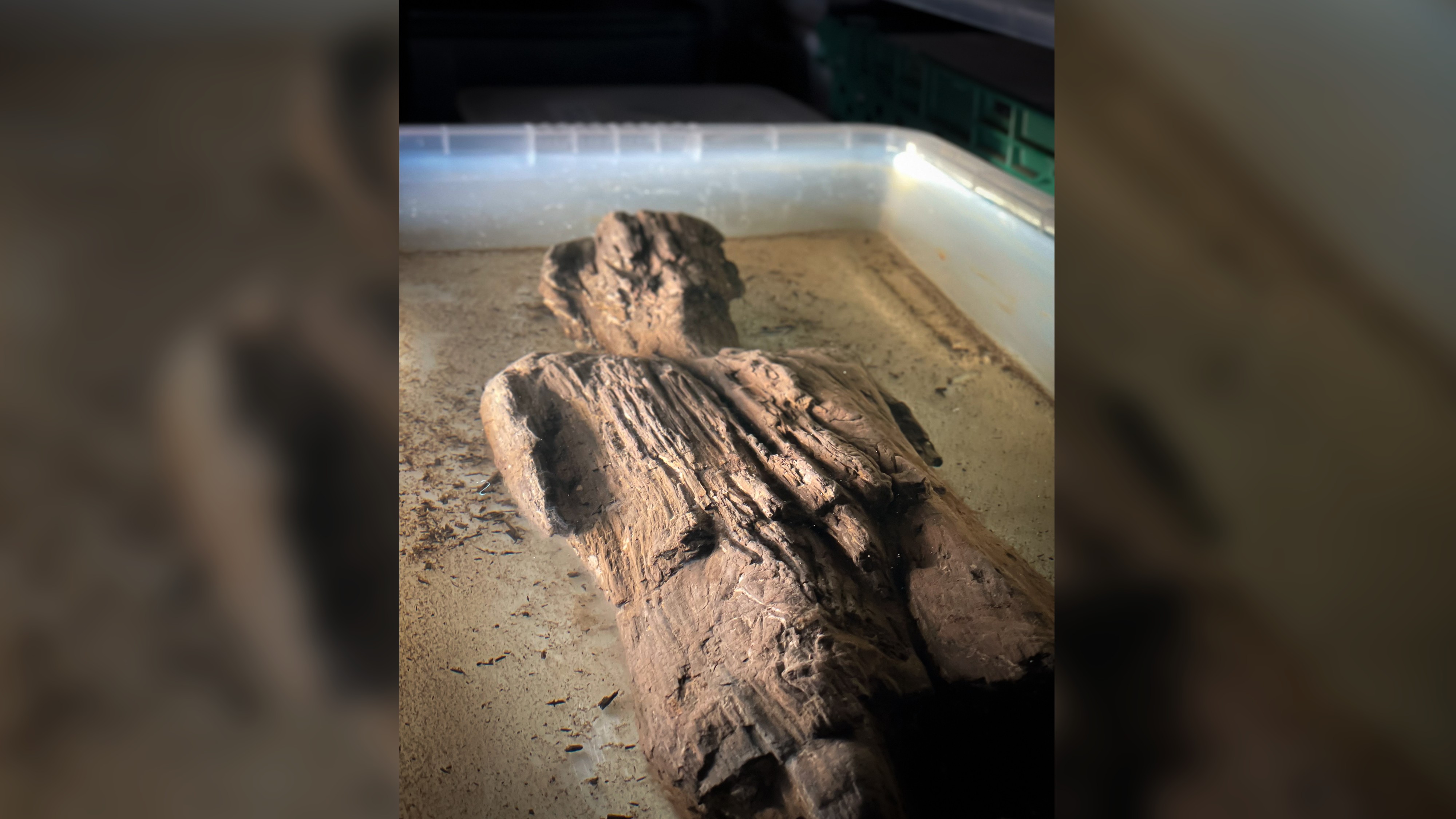'Exquisite' wooden figurine dating to early Roman Britain found in a ditch in England
The 2,000-year-old figurine shows a man in a tunic.

Archaeologists have unearthed an "extremely rare" carved wooden figurine, likely dating to early Roman Britain, in a waterlogged ditch north of London during excavations ahead of a major rail project.
The figurine is badly deteriorated, but it appears to depict a man dressed in a Roman-style tunic. Pieces of pottery were also found in the ditch and date to between A.D. 43 and 70, during the Roman conquest of much of Britain under the emperor Claudius, which occurred from A.D. 43 to around 84. (Julius Caesar staged earlier invasions of Britain in 54 B.C. and 55 B.C. but he achieved no permanent hold on the island.)
The archaeologists suggest the figurine may have been deliberately placed in the ditch as a religious offering; the practice of depositing objects and even human sacrifices in bogs and wetlands was common throughout Northern Europe before the Roman conquests.
Related: The most amazing coin treasures uncovered in 2021
"The preservation of details carved into the wood, such as the hair and tunic, really start to bring the individual depicted to life," archaeologist Iain Williamson of Fusion JV, a contractor for the government's High Speed 2 (HS2) rail project, said in a statement.
HS2 will eventually connect the English cities of London and Manchester, covering a distance of more than 300 miles (480 kilometers). By law, all the land along the route must first be investigated by archaeologists before any construction, so the project has become a major source of new archaeological discoveries.
Wooden figurine
The figurine was found in July last year near the village of Twyford in Buckinghamshire. According to the HS2 statement, archaeologists from the private firm Infra Archaeology were working for Fusion JV, the main contractor for the central stage of HS2, near a wetland site called Three Bridge Mill when they found what they thought was a rotten piece of wood in a waterlogged Roman ditch.
Sign up for the Live Science daily newsletter now
Get the world’s most fascinating discoveries delivered straight to your inbox.
Subsequent excavations revealed that it was a human-like figurine about 26 inches (67 centimeters) tall and 7 inches (18 cm) wide that had been cut from a single piece of wood.

"Not only is the survival of a wooden figure like this extremely rare for the Roman period in Britain, but it also raises new questions about this site," Williamson said. "Who does the wooden figure represent, what was it used for and why was it significant to the people living in this part of Buckinghamshire during the 1st century A.D.?"
One of the most surprising things about the find is that the figurine has been preserved at all. Wooden objects usually quickly rot away when exposed to oxygen, but a few ancient wooden relics have survived because they became buried in anaerobic (oxygen-free) conditions beneath layers of sediment — in this case, waterlogged clay in the ditch.
Ancient artifact
The figurine's arms have degraded below the elbows, along with its feet, but overall it is in good condition given its age, HS2's statement said.
"A surprising amount of detail remains visible in the carving, with the figure's hat or hairstyle clearly noticeable," the statement said. "The head is slightly rotated to the left, the tunic at the front seems to be gathered at the waist going down to above knee level, and the legs and shape of the calf muscles are well-defined."
A spokesman for the government heritage organization Historic England, which has studied the figurine, called it a "remarkable find."
"The quality of the carving is exquisite and the figure is all the more exciting because organic objects from this period rarely survive," Jim Williams, a senior science advisor with Historic England, said in the statement. "This discovery helps us to imagine what other wooden, plant or animal-based art and sculpture may have been created at this time."
The artifact is now being preserved and will undergo further examinations. A small, broken-off fragment of the figurine was also found in the ditch; the archaeologists hope to use it to give an accurate radiocarbon date for the wood, while stable isotope analysis of the fragment might reveal where the wood came from.
Originally published on Live Science.
Tom Metcalfe is a freelance journalist and regular Live Science contributor who is based in London in the United Kingdom. Tom writes mainly about science, space, archaeology, the Earth and the oceans. He has also written for the BBC, NBC News, National Geographic, Scientific American, Air & Space, and many others.









